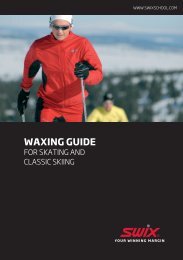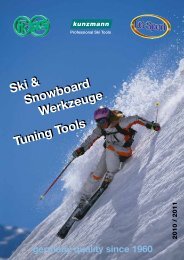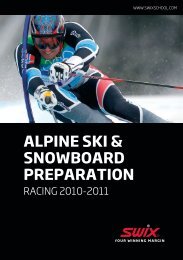NORDIC SKI PREPARATION
NORDIC SKI PREPARATION
NORDIC SKI PREPARATION
You also want an ePaper? Increase the reach of your titles
YUMPU automatically turns print PDFs into web optimized ePapers that Google loves.
ZERO-CONDITIONS<br />
First, we must define what we mean by the<br />
term ”zero-conditions”. In ski terminology “zeroconditions”<br />
means a situation characterized by<br />
air-temperature close to the melting-point, 0°C,<br />
in addition, there is typically falling or new fallen<br />
snow, which is usually moist. The conditions are<br />
further characterized by shiny, icy tracks after<br />
some use. Note that temperatures close to zero<br />
do not always result in the same challenge to<br />
waxing. If the snow has gone through one or more<br />
cycles of melt-freeze, the snow consistency does<br />
not change that rapidly around the critical temperature<br />
of 0°C.<br />
Due to the fact that kick waxes for these conditions<br />
are relatively soft, they are vulnerable to<br />
icing. Although it might be somewhat difficult<br />
to find the right wax for skating, the problems<br />
are mainly involving classical skiing. There are<br />
no exact rules to follow; however, we will give<br />
some general advice. As always, the choice of wax<br />
depends upon snow consistency, air-humidity and<br />
temperature. Just small variations in temperature<br />
cause large changes in snow consistency around<br />
the melting point where both ice, water and<br />
water-vapor might exist together. Falling or new<br />
fallen snow around zero normally calls for a soft<br />
type of hard-wax. Klisters are too soft. With more<br />
transformed snow and snow gradually building up<br />
free water, klisters begin to work.<br />
In between the extremes of using hard-wax<br />
and klister, there are many possible combinations,<br />
involving thin layers of klister, covered by hard<br />
wax. The hard wax protects towards icing and the<br />
bottom klister works as a “pillow”, giving improved<br />
kick.<br />
The Kick Zone<br />
Advanced skiers frequently have more than one<br />
pair of skis, selected for different snow conditions.<br />
In the racing shops you will find assistance<br />
to measure your personal kick-zone, depending<br />
upon weight, technique and ambition level.<br />
For racing, it is often common to have pairs for<br />
dry snow and pairs for klister conditions. The kick<br />
zone then is adjusted to the different conditions.<br />
If you have only one pair, to be used in all conditions,<br />
it is practical to have kick zone markings<br />
for dry snow, zero-conditions and klister. In this<br />
case the length will be shortest for the klister.<br />
However, it is hard to find a pair, working well in all<br />
conditions, due to differences in ski-constructions<br />
and base materials, but it is possible to do efficient<br />
adjustments to the glide zones using rilling<br />
tools.<br />
Waxing alternatives for different<br />
snow conditions<br />
Below we have given alternative solutions for<br />
waxing by different conditions. As mentioned,<br />
zero-conditions imply that small differences in the<br />
choice of wax might have large conse quences on<br />
the performance. Therefore, we always recommend<br />
accurate testing on the actual site. Even<br />
“experts” fail from time to time. Learn from experience<br />
and do the experiments while training and<br />
then trust your knowledge when racing!<br />
Falling and new-fallen moist snow<br />
Apply one layer of VG30 base wax by warming it<br />
into the base with an iron temperature of 110°C.<br />
Let the skis cool down to room-temperature.<br />
Apply a layer of V30 Blue, which also is warmed by<br />
iron at 110°C. Work carefully so that the blue wax<br />
covers the base wax and does not blend into it.<br />
Let it cool and work by cork T10 or T12 synthetic<br />
cork to make the surface smooth.<br />
Then cover this with thin layers of VR55,<br />
corking in between each layer. The number of<br />
layers depends upon ski stiffness, but normally<br />
we recommend 3-4 layers. If the skis are slippery,<br />
more layers or working with the softer waxes<br />
(VR60, VR65, VR70, VR75) are the two alternatives.<br />
It is not always necessary to start with the<br />
VR55. After some experience you might go directly<br />
to one of the softer waxes. However, there is a<br />
general rule to start hard and go softer. A soft wax<br />
which ices up has to be removed before a harder<br />
wax is applied.<br />
Tip 1: Use a relatively new cork working with soft<br />
kick waxes. On zero-conditions we stress the<br />
importance of exact corking. All irregularities in<br />
wax thickness might introduce icing.<br />
Tips 2: Do sufficient testing to judge the kick.<br />
In zero weather the skis often feel slippery in the<br />
beginning, but work well after the first 5-600<br />
meters. It is a common mistake to judge too early<br />
by testing too short, and go back and apply a wax a<br />
little softer, which might ice up or go too slow.<br />
Slush and falling wet snow («rubbingconditions»)<br />
Alt. 1<br />
Apply VG30 and V30 as described above. Apply 3<br />
layers of VR70, the last layer melted at 80-85°C.<br />
Work slightly to obtain a smooth, shiny surface,<br />
without pushing the wax to the sides or into the<br />
groove.<br />
Alt. 2<br />
Same procedure as Alt. 1, but substitute VR70<br />
with VR75. This might be a good alternative in<br />
steady precipitation.<br />
Alt. 3<br />
Spray on a layer of KB20 spray base klister. Then<br />
apply a thin layer of K21 silver universal klister.<br />
Once more we repeat the importance of a smooth,<br />
even layer. Let the skis cool down to surrounding<br />
temperature. Then add a layer of VR75 which<br />
should be ironed at 80°C (same as Alt. 1).<br />
Alt. 4<br />
Use Zero-skis (or rubbed skis). In many cases this<br />
will correspond to the ideal range of Zero-skis.<br />
See treatment of those below.<br />
Tip: Keep the skis moving; do not take off the skis<br />
outside the track. To go outside the trail, might<br />
cause instant icing.<br />
Glossy, shiny trails<br />
Alt. 1<br />
Spray on a layer of KB20 spray base klister. Then<br />
apply one thin layer of K22 VM universal klister.<br />
Smooth, even the layer out. Cool to surrounding<br />
temperature. Apply one layer of VR70 which then<br />
is ironed at 80-85°C.<br />
Alt. 2<br />
As Alt. 1, but K22 VM and K21 are blended in equal<br />
ratio.<br />
Alt. 3<br />
Apply one layer of KB20 spray base klister. Cover<br />
this with one layer of K22 VM universal klister.<br />
This alternative demands wet snow conditions.<br />
General tip: Zero conditions seldom cause much<br />
wear. A thick layer of wax is not necessary and<br />
might reduce glide too much.<br />
58 59





